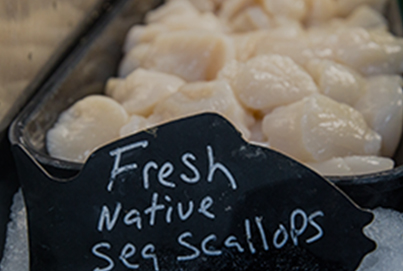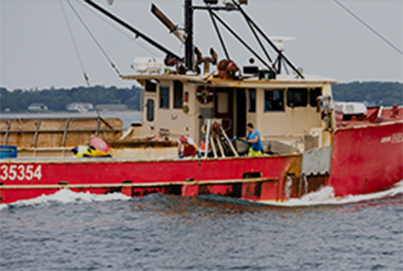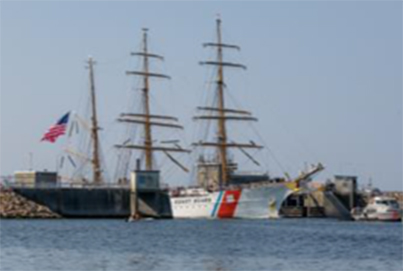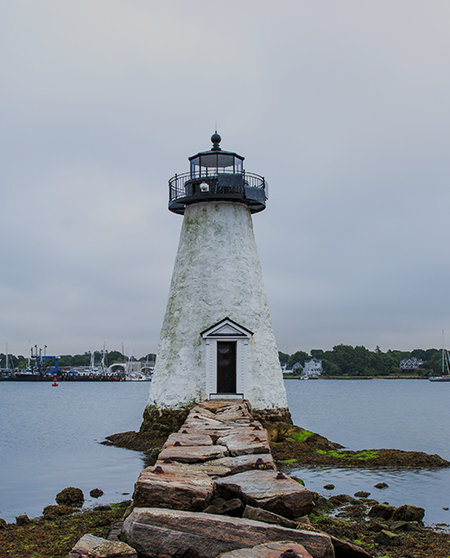THE PORT OF NEW BEDFORD IS A THRIVING MARITIME CENTER
The Port of New Bedford is a thriving maritime center, home to a number of blue economy professionals and businesses, including seafood processors, gear manufacturers, fishermen, shoreside support services, scientists, academics, and marine tech professionals. And in the coming years, the Port of New Bedford will also support aquaculture farmers and the offshore wind industry.
It is the Port of New Bedford’s mission to develop economic growth strategies along the waterfront. There is always an opportunity to do business with a number of the local, marine-based businesses in our thriving marine industrial port, and we welcome your inquiries. It is the New Bedford Port Authority’s goal to connect any individual interested in doing business in the Port with the appropriate partner(s).
Commercial Fishing
In 2014 the Port handled 140 million pounds of domestic seafood and 250 million pounds of foreign seafood. As reported in the 2016 Economic Impact Report: “From the processor, the seafood can be trucked locally to wholesalers, go to a cold storage warehouse, trucked to an airport such as Boston’s Logan International Airport or New York’s John F. Kennedy International Airport where it is flown to various domestic and international destinations, or trucked to the Port of New York New Jersey where it is put on container vessel to be shipped internationally. It can also be trucked from New Bedford to Worcester where it is railed out to the West Coast for export to Asia.”
The Port of New Bedford has been the nation’s number one most valuable fishing port since 2001.
Municipal Piers and Wharves
We have made significant repairs and improvements to Coal Pocket Pier and Steamship Pier over the past year with funding from the NBPA and a grant from the Seaport Economic Council.
Facility |
Linear feet of berthing space |
Number of Berths |
Number of Vessels |
Steamship |
1,300 |
15 |
50 |
Leonard’s |
950 |
12 |
40 |
Fisherman’s |
940 |
9 |
30 |
Homer’s |
850 |
12 |
30 |
Coal Pocket |
260 |
4 |
10 |
South Terminal
History of NBPA Piers and Wharves
- Homer’s Wharf (also called Merrill’s Wharf) houses some of the waterfront’s seafood processing companies and provides berthing for commercial fishing vessels.
- Leonard’s Wharf is home to fishing boats and the majority of the Port’s lobster boats. The wharf is named for Samuel Leonard, founder of a lumber company located on the site in 1840. Lumber from the East Coast and the Pacific Northwest was off-loaded and planed in an adjacent mill.
- Steamship Wharf was rebuilt and doubled in length in 1979 and today houses many fishing and lobster boats. Expansion is possible by limited by its proximity to State Pier and the large vessels there impeded maneuvering capabilities. This historic pier, which is included on the National Register of Historic Places, once served as a terminal for ferries operating between New Bedford, Martha’s Vineyard, and Nantucket, and for service from Boston, New York City, and New London.
- Coal Pocket Pier is used for berthing fishing and lobster boats. During the golden age of whaling, this short pier was a receiving point for thousands of casks of whale oil. The pier got its name in the late 19th century when coal was stored in tall containers, or pockets, until being shipped out by wagons, and later, by trucks. Due to the Pier’s size and orientation, expansion is impossible.
- Fisherman’s Wharf was originally two piers – City Pier #3 and #4. The wharf provides additional berthing for the New Bedford fishing fleet and is currently overcrowded with limited space for expansion. The wharf has served a variety of vessels from the early whalers in the 1800s to modern fishing draggers and scallopers in the Port today. Also docked at Fisherman’s Wharf are the Alert (II), a passenger ferry to Cuttyhunk Island, and the Acushnet, Whaling City Tour’s vessel providing harbor tours and launch and water taxi service.
- South Terminal Offloading Docks consists of a 1,600-linear foot bulkhead that supports the off-loading of fish product. The facility also supports eight fish processing houses.
Permits and Dockage Rates
Docking Permits
Dockage rates are established by the Commissioners. Effective January 1, 2017, dockage rates are $45 per foot.
Unloading Fees
The offloading rate for vessels that homeport, but just use NBPA infrastructure to offload product is $1000.00/year.
Transient rates for berthing and off-loading
- Dockage – up to & including boats 50 ft in length – $100.00/day
- Dockage – over 50 ft – $200.00/day with annual cap of $45 per foot
Refer to NBPA Rules and Regulations
Please note: As part of the operation of NBPA’s piers and wharves, the Harbormaster officials work to reduce the number of abandoned or derelict vessels scattered throughout the harbor. These vessels, which are left unattended for extended periods of time, sometimes years, occupy scarce berthing space that could otherwise be used by active vessels. Additionally, there are concerns surrounding the safety of these neglected vessels, which have been reported to break free and damage adjacent property during periods of high winds and other severe weather conditions. If a vessel(s) is in violation of NBPA laws, rules and/or regulations, even if fee payments are up to date, it is protocol to no longer allow the vessel(s) to berth at NBPA facilities, as directed by the NBPA Rules and Regulations. The NBPA reserves the right to send a ‘No Trespass’ or a notice to remove the vessel and/or pursue the owner with criminal charges.
User Permits
User (Daily) – $50.00
User (Annual) – $300.00
User (Additional Annual Mobile, Welding, Painting Rafts) – .$75.00
Operational rules, including permit conditions and rates/fees are set by the NBPA Commissioners. The NBPA assesses user charges for private contractors and dockage as well as sets unloading fees for vessels that use its facilities or public infrastructure. The revenues are used to operate and maintain properties. Enforcement and billing are handled by the NBPA Marine Superintendents and Harbormaster officials. The Financial Manager tracks and issues payments.
Parking Program on NBPA Piers and Wharves
NBPA Rules and Regulations
Download the Municipal Pier Rules and Regulations (effective February 2009) and the Mooring and Anchoring Rules and Regulations (effective July 2011)
Studies/Reports
- Link to SMAST 2014 Report
- Link to Martin Study
Aquaculture – To Be Developed
Offshore Wind
In 2016, Governor Charlie Baker signed the Act to Promote Energy Diversity, allowing for the procurement of up to 1,600 megawatts of offshore wind energy by 2027. And in May 2018, the first winning bid was announced to Vineyard Wind for 800MW of offshore wind energy; Vineyard Wind also signed an 18 month lease with the Marine Commerce Terminal in October 2018.
The Port of New Bedford is poised for the development of the offshore wind industry. As the leading, most valuable commercial fishing industry in the country, New Bedford is also one of few marine industrial working waterfronts on the east coast that is home to a full suite of shoreside services that can support diverse industries.
As the commercial fishing industry continues to consolidate, the Port of New Bedford remains a global hub for landing and processing seafood, supported by ample infrastructure and shoreside services that strengthen the Port’s ability to attract and support new marine industry. While many see the fishing industry as a barrier to offshore wind, we see it as providing us with a competitive advantage – the full supply chain that is already in place to support commercial fishing can also support the offshore wind industry.
As the offshore wind industry continues to develop further south, impacting additional fishing communities, the lessons learned through their work with the Port of New Bedford will only set them up for greater success as they expand operations. Time invested working with the Port of New Bedford to ensure compatibility in shared ocean space with commercial fishermen will save time and effort over the long-term expanding south and in the Pacific Ocean.
Due to our long history as a marine industrial working waterfront, the Port of New Bedford is dedicated to advocating for maritime-based infrastructure needs, maritime-based workforce development, and maritime-based public policy, which also suits the development of offshore wind.
Wind Energy Center
Link
—-Facilities/Infrastructure
Other Harbor Users
—–Facilities/Infrastructure
- Link to State Pier/Mass Development
- Link to other?
Othe Harbor Users
Sponsors of regattas and races must obtain permission from the NBPA to operate in city waters at least 30 days before the event. No fee is usually required. Organizations wishing to use city piers and other facilities for weekend or holiday activities, such as concerts and festivals, also must obtain the prior permission of the NBPA. Although no fee is usually required for special events, organizers must provide the NBPA with a valid certificate of insurance in an amount specified by the NBPA. The City of New Bedford has permit requirements for special events.
Passenger Ferry Shuttle Services and Whale’s Tooth Parking Lot
Whale’s Tooth Parking Lot employees include two full-time bus drivers. In the busy summer season (April to the end of September when the Martha’s Vineyard ferry runs), employee support is expanded to include an additional bus driver, a trolley driver, a cashier and parking attendants. NBPA Commissioners decide, in concert with recommendations from SeaStreak, on winter ferry service.
Cruise Ship Berthing on State Pier
The Facilities Manager also coordinates/provides trolley service to transport cruise visitors on excursions to the various City destinations. The New Bedford Economic Development Council markets these shore-side excursions along with the NBPA Marketing, Retail and Procurement Team. Cruise passengers are provided with welcome brochure that includes a downtown map, coupon booklet and other promotional materials for New Bedford businesses and attractions.
Redevelopment
Next steps……
COMMERCIAL FISHING
OFFSHORE WIND
OTHER HEADLINE
COMMERCIAL FREIGHT
LATEST NEWS
EVENTS
Receive the Latest Notices and Advisories









